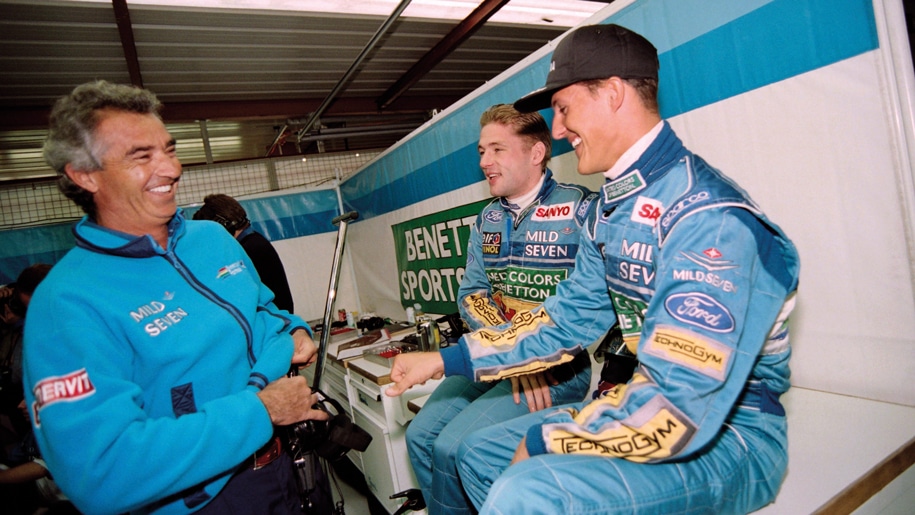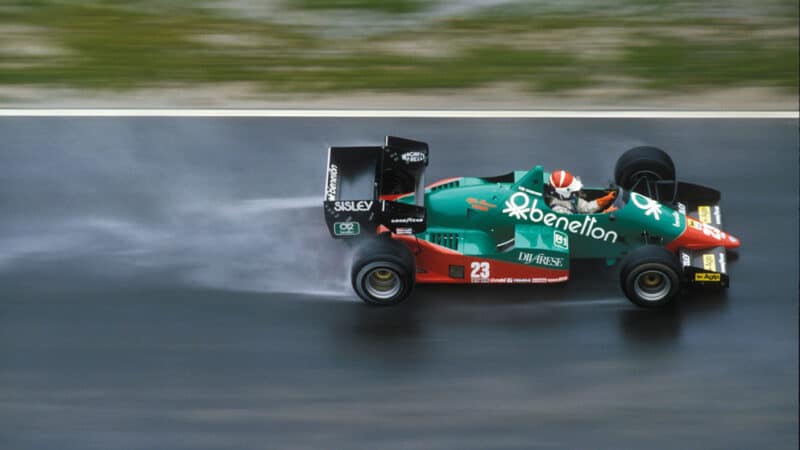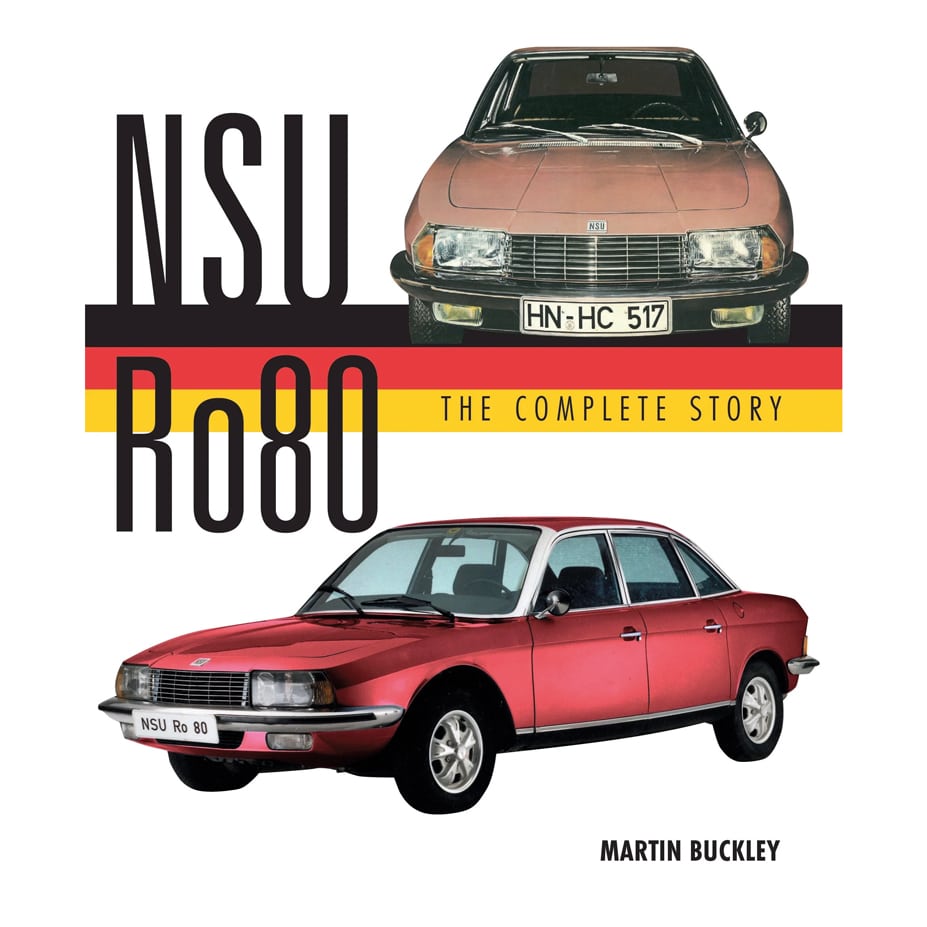Benetton — Rebels of Formula 1 book review
A weighty book about Benetton’s rise and fall in F1 is as vibrant as the team’s racing car liveries, says Gordon Cruickshank

Force of nature Flavio Briatore with Michael Schumacher and Jos Verstappen in 1994 – the year of Benetton’s first world title
AFP via Getty Images
When in 1985 an Italian sweater firm bought a complete Formula 1 team, new ground was broken, a hint of the eagerness to disrupt the status quo that would characterise the clothing firm across everything from eye-catching product to provocative advertising to highly coloured sponsorship. And it’s clear from those interviewed in this authoritative work by Damien Smith, a former editor of Motor Sport, that this lateral approach carried over into the racing – Smith calls them “rebels of Formula 1”.
Not that this was Benetton’s first plunge into F1. That came with Tyrrell in 1983 after a couple of people had sparked the idea in Luciano Benetton, including new head of communications Davide Paolini who says, “I obliged the Tyrrell mechanics to wear pink shirts to attract photographers.”
But the future wasn’t with Tyrrell, who didn’t want to go turbo. So it was Alfa Romeo’s turn to wear the green and even brighter mechanics shirts; but 1985 was the sad end of that Alfa era – which didn’t bother Benetton so much. It had a plan, and that plan would turn out to be a pretty good one: Toleman.
In his rundown of Toleman’s origins, Smith slips in a photo of Colin Hawker’s DFVW, the Cosworth-powered super saloon I remember watching at Ingliston. A moment of nostalgia that pinpoints the event that lured the Toleman Group into racing, directors Alex Hawkridge and Ted Toleman forming an F2 team and soon taking on a South African designer called Rory Byrne. It’s clear by now that the author has chased up a huge spread of voices – Hawkridge, Byrne, designer John Gentry, and Derek Warwick who shone in Byrne’s car. All talk about the team’s progression to F1 and how ‘promising’ became ‘astonishing’ as new boy Ayrton Senna almost pulled off that Monaco 1984 victory.
Optimists will tell you that problems are really opportunities. For 1985 Toleman struggled for tyre supplies and looked in grave danger of collapse despite the TG185’s fine qualities. This was when Benetton stepped in with £2m and big ideas.

Benetton – Rebels of Formula 1
Damien Smith
Evro Publishing, £60
ISBN 9781910505588
Tales of a team’s rise to success can be samey but this is a story with so many inside views: Pat Symonds on a sneaky trick with the BMW turbo black box, Byrne confirming their 1300bhp, team manager Peter Collins saying “getting Cosworth up to speed was like pulling teeth”. Engine reliability was a recurring bugbear, but Gerhard Berger, Teo Fabi and Thierry Boutson all waved the multicoloured flag with varying success; the wider achievement was company exposure, with a marketing specialist pushing the Benetton name into the lifestyle world. That and highly provocative billboard and magazine adverts, sometimes banned, gave Benetton the edgy profile it craved.
It didn’t hurt that the small, tight team punched above its weight, a roster of drivers – now including Boutsen and Alessandro Nannini – putting up poles, podiums and victory for Berger. Then a shaggy-haired businessman called Flavio Briatore (“Flav the Impaler” jokes Smith) took the team manager slot, and Michael Schumacher arrived… Well, you all watched that play out on the screen – two world championships and the constructors’ title for the team, part of controversial Briatore’s 20 years as the wild man of F1. Smith is impressed, calling him “devastatingly effective” and “a platinum-grade F1 winner”.

Cheever struggles with the thirsty V8 184T as Benetton turns to Alfa in 1984 – but not for long
Although Briatore was shoved in, the team soon settled to the family feeling Tolman had enjoyed, and Smith contends this remains the same in the team’s current guise as Alpine. (This is the outfit which has had so many labels it’s often referred to nowadays merely by its base – ‘the Enstone team’.)
“They were really good owners,” says technical director Symonds of the family with genuine affection, continuing that Luciano B was fascinated by technology which explains some of his attraction to F1.
Not that things were always ‘nice’: Collins tells how he was made to dump Johnny Herbert and then leave in turn; a prickly John Barnard says he couldn’t care less if they didn’t like him. Flav comments, “If you sent John to Switzerland you’d have a war the next day!”
Benetton stalwart Symonds, whose presence in F1 has been long and significant, is something of an anchor through the book, and a perfect one, a scaffolding for Smith’s dedicated research. Woven among the racing – and many fine photos – there’s a great quote on almost every page, sparkling bubbles that keep things fizzing. On the Hockenheim pit inferno of 1994 Smith talks to most of those involved including Steven Tee who captured that famous photo. “All I could see in the viewfinder was an orange flash.”
Benetton triggered plenty of ‘legality questions’ and Smith lets everyone talk, on the fire’s cause, illegal planks, launch programmes, the controversial ’94 title, a diplomatic Damon Hill saying, “They were prepared to do a lot to push the boundaries…”
As if to keep the energy up Smith waits until the post-Schumacher trail-off when the equipe had lost works engines to describe the partying and team holidays. One mechanic comments, “If you didn’t come in with a hangover it was frowned upon.” Benetton seems to have taken on Hesketh’s slot as the fun team. There was less fun about results and team affairs by 1997, when David Richards was sent in unannounced to fire and replace Flavio. “It was like one of those gangster films,” Richards says. “He looked up from his desk and said, ‘I wondered who it was going to be.’”
But Benetton needed an engine partner, and Regie Renault needed a team for its F1 comeback – steered by Flav. From 2002 Benetton became Renault and a chapter closed. Smith’s close is an interview with Alessandro Benetton which colours in why a family clothing firm became F1 winners, and why team manager Joan Villadelprat feels, “Benetton was a special place to be. Everybody there loved Benetton, everybody had good times.” A decade and a half of good times isn’t bad, and they couldn’t be better conveyed.
Le Mans winning colours
Mick Hill
Every Le Mans-winning car from 1923 to 2022, illustrated in profile with a stats summary. That’s the simple premise of Mick Hill’s book and it’s an appealing one – flick through and watch the sports car evolve from road vehicle to mobile tech flagship. A short intro heads each decade; for model makers it’s a valuable reference, especially as technical illustrator Hill has worked with many race teams. GC
The History Press, £25
ISBN 9781803992013
NSU Ro80
Martin Buckley
Always had a soft spot for the Ro80 – bar the usual concern about the rotary mill. Martin Buckley has the first full story of this car with its futuristic look and effortless poise, outlining its origins, development and what it might have led to. Packed with facts about the engine, those involved (including the tragedy of the car’s stylist who killed his own son) and the market the car was chasing and finally lost. A great history for a great car. GC
The Crowood Press, £30
ISBN 9780719841743
Fast Lady
Michael W Barton
A full investigation into the life of pioneer early motorist Dorothy Levitt. Michael W Barton digs up every reference to a lady who entered speed and reliability trials before World War I, acclaimed as “the fastest girl on Earth”. She won medals in motor boats, too. Protégée of SF Edge of Napier Cars, Levitt was good for, and at, publicity, retelling her doings in books and journals. Barton’s research reveals frequent speeding fines among the auto events but after her short career there’s something of a blank until her early death, and even his doggedness can’t produce much firm detail after her moment as champion of women’s right to compete. And all in long dresses. GC
Butterfield Press, £40
ISBN 97819996325



